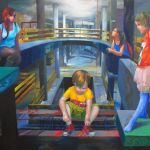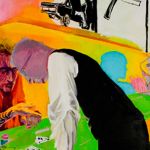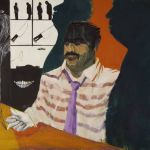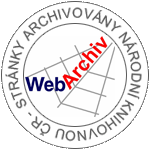Traffic (letní provoz)



Překvapivě domácky mezinárodní projekt, který jsme vetkli do prázdninové pauzy ve výstavním programu galerie OFF/FORMAT.
Koncept čtrnáctidenní výměny byl především institucionální spoluprací mezi kurátory-umělci poznaňské galerie a kurátory-umělci naší galerie. Na přelomu července a srpna 2016 se tak představila v brněnské galerii OFF/FORMAT dvojice polských malířů, Joanna Marcinkowska a Tomasz Kalitko, a v Poznani v galerii TRAKCJA Ondřej Navrátil a Petr Kovář.
Autoři nebyli nijak tematicky omezeni, pojítkem čtyř výstav se tak stal základ společného názvu Traffic (Provoz), který si každý z účastníků interpretoval a doplnil vzhledem k zaměření svých prací. Joanna Marcinkowská, jež se ve svých malbách věnuje tématu domova, vyjádření vztahů mezi blízkými lidmi a prostředím, v němž žijí, nazvala svou expozici Traffic home. Marcinkowská často těží z kontrastu, jak výbušně barevného, tak obsahově emočního, když například motivy vystihující domáckost a blízkost zasazuje do odcizeného chladného prostoru imaginární architektury.
Tomasz Kalitko se dlouhodobě zabývá tématem ulice, v němž se střídají narativní obrazy cvrkotu města a magičnosti vyvstávající z anonymity a ignorace davu, stejně tak jako obrazy z masy vyplouvajících rázovitých postav, pouličních rvaček a lokálů. Obliba v ostrých kontrastních barvách, podobně jako u Marcinkowské, je adaptována na místy až komiksovou formu malby sympaticky nadsazených „historek z posvětí“. Kalitko nazval svou výstavu Traffic City.
Jako zajímavý kontrast do třetice pak působila česká výstava oproti polské. Jednak výrazně konceptuálním pojetím, jednak téměř černobílou (ne)barevností. Odlité čokoládové ikony, malby čokoládou na plátně a hravě analytické kresebné obrazy Ondřeje Navrátila (Traffic image) i vyšívaná plátna Petra Kováře (Traffic of vision) se vyznačují směřováním k elementárnímu vyjádření, k postižení zkoumaného minimalistickou oproštěnou, a přitom výraznou formou.
Spolupráce zapouští hlubší kořeny, takže v blízké době se snad uskuteční jak další výměnné výstavy podobného ražení, tak třeba společná výstava dalších umělců z obou stran naštěstí stále tak otevřené hranice. I to je důvod, proč je ohlédnutí za loňským letním provozem stále aktuální, z letního provozu rozlet.
Joanna Marcinkowska, Tomasz Kalitko / Traffic, galerie OFF/FORMAT, 25. července – 14. srpna 2016.
K výstavám vznikly malé skládací katalogy, z nichž zde uvádíme texty o autorech v anglickém „originálu“:
Traffic City / Tomasz Kalitko
Broadway Junction is one of the biggest, and surely one of the most monumental, interchange stations in Brooklyn. This multi-storey open-air museum of the 19th century blood-thirsty capitalism differs from the Eiffel Tower in the fact that like everything in the US is practical and really used every day, and does not only arouse admiration for the architectural thought in itself.
This example of an interchange station etched on my memory both because of its unusual structure and also due to my short, almost everyday visits at the place.
Broadway Junction inspired me a lot especially because it is teeming with life; thousands of people pass each other every day. It causes that the personification of the crowd is transferred to another level. After a few months it is possible to recognise the same jacket, which produces a sense of closeness; the same curly hair, which gives comfort as we know that the subway train has not arrived yet; a plastic shopping bag denotes your compatriots – Poles. This kaleidoscopic rhythm caused that I perceived my everyday journeys as if frame by frame and each week I needed fewer frames to reach my destination. Finally I did not remember long distances of the way.
Then I thought about the contemporary narration: how much it differs from linear stories with their introduction, development and ending, with heroes who have their own personal traits. Being in such a layered society I came to understand that the idea of three-act structure of the classical drama will not work in this situation. In the third act nobody will shoot a rifle, which so much intrigued the audience in the first act. Nobody will even pay attention to it. The contemporary narration is an additional, open window on a computer screen, a multitude of messages which we, equipped with knowledge, do not see. Finally, it is simply a typical change of plans or subjects. Just like the contemporary cities do not possess a clear centre but many various centres and squares, in the same way the flashing images of the people passing by make that none of the people is in any way more important and the relations between passers-by are shaped by the subway timetable.
Traffic home / Joanna Marcinkowska
A railway station, a street, a subway station, a hospital - the places which are to the same extent real and imagined. Each time inspiring - shared space. They are often a compilation of several various, overlapping areas. These places are cold and unfriendly by definition. However, I frequently introduce the characters from my paintings into them as if to a family home, child’s bedroom or a sunny garden. And I leave them between the familiar and warm and the cold and distant.
I am interested in contrast and ambivalence both as a painter and from the point of view of meaning. What attracts me is the thing that reveals itself at the border between seemingly incongruous plans. These contradictive juxtapositions help me convey a certain expressive tension as well as a state of uncertainty and understatement, which are particularly important to me.
Traffic image / Ondřej Navrátil
Ondřej Navrátil has experimented with plenty art media, however, he has devoted his work to drawing. He puts its rational concrete version in contrast with illusion of opposingly different position of expression. He plays with both the poles and with his peculiar sense of humour and personal fascination he highlights the mental-physical moment of a unique creative gesture. Ondřej also relates to the same theme in his canvasses that are minimalistically divided by vertical and horizontal lines. We can observe the lines accurately follow the structure deformations of painter canvass. In that way they emphasize the result of author's first creative step stretching the canvass, while this intervention is always individual and comes out of artist's unique inner and outer conditions. Another Navrátil's long-term theme, which is closely connected with his degree in art history, is historic art mostly of European Middle Ages and early modern times. He creates paraphrases of period artworks from unconventional, yet referring ephemeral materials. They are afterwards left at the mercy of natural (de)forming processes. Despite the fact he values the inspiring artworks from their aesthetic point of view, his attention is drawn by their once sociocultural role and stereotyped meaning seen by period public. Chocolate is understood mainly as a metaphor for their alleged spiritual and idealistic essence. The whole collection can be viewed as a light and biased commentary on some powers and ideas traditionally associated with formation and effect of an art work.
Traffic of vision / Petr Kovář
Paintings of Petr Kovář are based on a real motive which he is changing in the process of his work and making simpler, looking for something more basic, what may appear while insignificant begins to blend, and is absorbed by energy of the unit.
The result then teeters on the brink between the familiar and undefined, personal and more universal, sometimes serious and grotesque.
The author is characterized by terse expressive shapes which he builds using drawing – delimiting by a thin line of taut thread. His approach is constructive, thread and safety pins stuck into them suggest the plane of intellectual game. However, while the author´s needle emphasizes and confirms something, other is suppressed and concealed. Of particular theme arises again seemingly deformed, as if absorbing itself in shape. In the perception of the viewer, Kovář´s paintings act as a call for imaginative games. The conceptual pun with pins also underscores it. This suggests the possibility of transformation, emphasizes unfinished, temporary status quo, which the author may (or someone else) develop further. Viewers´ associations can then produce images of very specific events, timeless symbols, or vague ones, but full of emotional resonance. This content richness is conditioned by sensitive settling the final shape to the irritating interface of the real and abstract, to the moment of birth and death of what is and is not part of our normal experience. The transit area, while ... and in the meantime.
(Ondřej Navrátil, adapted text to the exhibition While and in the meantime, Milan Zezula Gallery, Brno, 2014)

